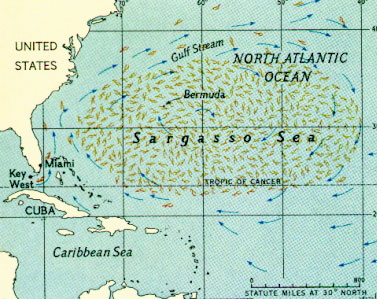Sargassum
Sargassum

Introduction
Sargassum is a type of brown algae[1] which often serves as a Macroalgal Bed in oceans. Sargassum algae serves several benefits to marine life, providing food, refuge, and breeding grounds to much fishlife. Due to impacts of climate change, in recent years sargassum has grown at an uncontrollable rate and beginning to threaten reefs.
Habitats and Location of Sargassum
 Sargassum are generally found in “tidal splash zones, rocky marine pools, the intertidal zone, coral reefs and moderately deep coastal zone waters”[1]. Sargassum is found in throughout the Gulf of Mexico and North Atlantic[2]. Sargassum typically circulates in those regions and towards the Sargasso Sea in the North Atlantic Ocean, which is 1000 km wide and 3200 km long[3]. Scientists estimate that the Sargasso sea contains up to 10 million metric tons of Sargassum[3]. In the spring and summer, the seaweed typically arrives on shores in the Gulf of Mexico, the southern U.S. Atlantic coast and the northern Caribbean, crowding beaches[2]. As the seaweed has become more dense and widespread it washes up on these beaches more frequently, and has even been found on the Western Coast of Europe[4] where it is invasive and non-native to these coastal areas.
Sargassum are generally found in “tidal splash zones, rocky marine pools, the intertidal zone, coral reefs and moderately deep coastal zone waters”[1]. Sargassum is found in throughout the Gulf of Mexico and North Atlantic[2]. Sargassum typically circulates in those regions and towards the Sargasso Sea in the North Atlantic Ocean, which is 1000 km wide and 3200 km long[3]. Scientists estimate that the Sargasso sea contains up to 10 million metric tons of Sargassum[3]. In the spring and summer, the seaweed typically arrives on shores in the Gulf of Mexico, the southern U.S. Atlantic coast and the northern Caribbean, crowding beaches[2]. As the seaweed has become more dense and widespread it washes up on these beaches more frequently, and has even been found on the Western Coast of Europe[4] where it is invasive and non-native to these coastal areas.
Biology
Appearance and Composition
Sargassum is a type of brown algae, genetically similar to yellow-green algae[1]. which can appear anywhere from green to red in color. There are over 2800 estimated species, a number which has grown in recent years[1]. Brown algae are slender, and often branch with multiple thin tubes and large leaves[1]. Additionally, it often branches oxygen filled “berries” (ocean explorer). Sargassum may be macroscopic or microscopic[1]. Sargassum typically grows to about 2-3 meters, but there have been documented cases of Sargassum growing up to 16 meters[4]. A sargassum plant lives for approximately 3-4 years[4].
Reproduction
Ecology
 Floating Sargassum beds serve critical ecosystem functions to a variety of marine species. These habitats contain a diverse assemblage of creatures including fish, sea turtles, and over 145 species of invertebrate, including sponges, fungi, bacteria, and protists. [5]
Floating Sargassum beds serve critical ecosystem functions to a variety of marine species. These habitats contain a diverse assemblage of creatures including fish, sea turtles, and over 145 species of invertebrate, including sponges, fungi, bacteria, and protists. [5]
Ecological Roles
Sargassum beds can form floating rafts that extend for miles across the ocean. The majority of sargassum is found in the Sargasso Sea, known as the "golden floating rainforest" because of its rich biodiversity. [3] These rafts provide habitats, food, and breeding grounds for a variety of marine organisms, and some creatures, like the Sargassum fish, live their entire lives in sargassum. [6]
Nurseries
Sargassum beds provide a nursery area for many commercially important fish species such as mahi mahi, jacks, and amberjacks.[6] Additionally, juvenile sea turtles often hide from predators among the sargassum.[3]
Food
Sargassum rafts serve as feeding grounds for fish, seabirds, and other organisms in the open ocean. When the algae dies, it sinks and provides organic carbon to the water column and seafloor. It may act as a supplementary food source for bottom-dwelling organisms in the deep sea.[6]
Shelter
Environmental Impacts
Coral Reefs
Climate Change Effects
Human Influence
Notes
- ↑ 1.0 1.1 1.2 1.3 1.4 1.5 http://www.eoearth.org/view/article/150791/
- ↑ 2.0 2.1 http://www.newsweek.com/2015/07/10/sargassum-ruining-beaches-texas-tobago-347735.html
- ↑ 3.0 3.1 3.2 3.3 http://www.onecaribbean.org/wp-content/uploads/SargassumResourceGuideFinal.pdf
- ↑ 4.0 4.1 4.2 http://www.seaweed.ie/sargassum/
- ↑ http://link.springer.com/article/10.1007%2Fs00227-014-2539-y
- ↑ 6.0 6.1 6.2 http://oceanexplorer.noaa.gov/facts/sargassum.html